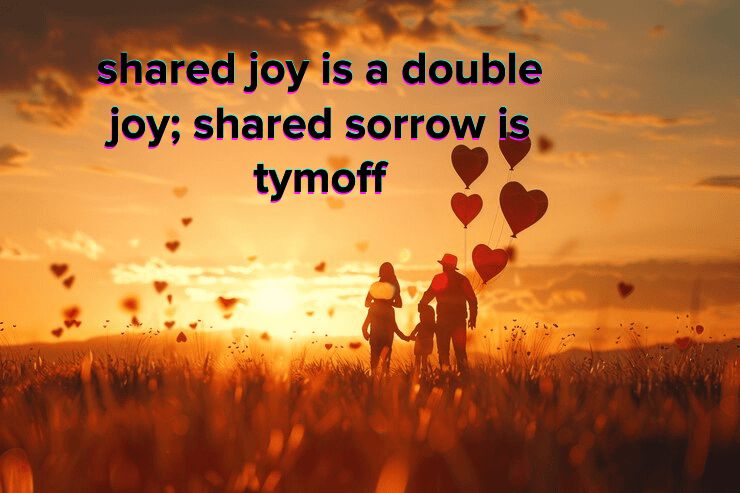In a world often characterized by its fast pace and individualistic pursuits, the essence of human connection remains a timeless treasure. We’ve all heard the saying: “Shared joy is a double joy; shared sorrow is tymoff.” But what does it truly mean, and why does it hold such significance in our lives?
As social beings, we crave connection—it’s woven into the fabric of our existence. Whether through moments of elation or times of despair, sharing these experiences with others enriches our lives in profound ways. In this article, we’ll delve into the depths of this age-old adage, exploring its implications and uncovering the transformative power of shared emotions.
Understanding the Adage: Shared Joy Is a Double Joy; Shared Sorrow Is Tymoff
At its core, this adage encapsulates the essence of human empathy and solidarity. It speaks to the notion that when we share our joys with others, those moments of happiness are magnified, becoming even more fulfilling. Conversely, when we confront sorrow alongside companions, the burden feels lighter, offering solace in shared understanding.
But why does this phenomenon occur? What is it about sharing our experiences that enhances their impact on our lives? Let’s unravel the intricacies of shared joy and shared sorrow to uncover their profound significance.
The Power of Shared Joy
Amplifying Happiness
- When we experience moments of joy, whether big or small, sharing them with others amplifies their significance.
- Have you ever noticed how a shared laugh with friends or loved ones feels infinitely more enjoyable than laughter in solitude? It’s like adding fuel to the fire of happiness!
- Through shared joy, we not only celebrate our own achievements and victories but also bask in the collective warmth of communal happiness.
Strengthening Bonds
- Sharing joy fosters deeper connections with those around us. Whether it’s celebrating milestones, achievements, or even the simple pleasures of life, these shared experiences create bonds that withstand the test of time.
- Think about the last time you celebrated a joyous occasion with friends or family. The memories created during those moments often become cherished treasures, reinforcing the bonds of friendship and love.
Cultivating Gratitude
- When we share our joys with others, it cultivates a sense of gratitude within us. We become more appreciative of the relationships and connections that enrich our lives.
- Expressing gratitude not only enhances our own well-being but also strengthens the fabric of our social interactions, fostering a culture of positivity and reciprocity.
Embracing Shared Sorrow

Finding Solace in Connection
- Just as shared joy amplifies happiness, shared sorrow offers solace in times of distress. When we confront challenges or hardships alongside others, the burden becomes more bearable.
- Have you ever experienced the comfort of a friend’s presence during a difficult time? Their empathy and support can provide much-needed strength and reassurance.
- Through shared sorrow, we realize that we’re not alone in our struggles—that others are willing to stand by us, offering a shoulder to lean on and a listening ear.
Building Resilience
- Sharing sorrow fosters resilience and emotional fortitude. By acknowledging and confronting our pain in the presence of others, we learn to navigate adversity with greater strength and resilience.
- The support and empathy of friends, family, and community members play a crucial role in helping us weather life’s storms, emerging stronger and more resilient than before.
Fostering Empathy
- Experiencing shared sorrow fosters empathy and compassion. When we witness the struggles of others and offer our support in their times of need, it deepens our understanding of the human experience.
- Through empathy, we forge deeper connections with those around us, transcending barriers of difference and fostering a sense of unity and solidarity.
FAQs: Unraveling Common Questions
Q: Can shared joy and shared sorrow occur simultaneously? A: Absolutely! Life is a tapestry of emotions, and it’s entirely possible to experience moments of joy and sorrow in tandem. In fact, sharing both experiences with others can lead to even deeper connections and a richer tapestry of human experience.
Q: How can I cultivate a culture of shared joy and shared sorrow in my relationships? A: Cultivating a culture of shared emotions begins with open communication, empathy, and vulnerability. Take the time to celebrate the joys and support each other through the sorrows, fostering an environment where emotions are embraced and shared openly.
Q: What if I struggle to express my emotions or connect with others on a deeper level? A: It’s okay to struggle with emotional expression—it’s a journey that we all navigate at our own pace. Start by cultivating self-awareness and practicing empathy towards yourself and others. Seek support from trusted friends, family members, or mental health professionals if needed.
Conclusion: Embrace the Power of Connection
In a world brimming with challenges and triumphs, the adage “shared joy is a double joy; shared sorrow is tymoff” serves as a poignant reminder of the transformative power of human connection. Whether we’re celebrating life’s joys or navigating its hardships, sharing these experiences with others enriches our lives in ways beyond measure.
So, let’s embrace the beauty of connection—the shared laughter, the comforting embrace, the empathetic presence. Let’s celebrate each other’s joys with unabashed enthusiasm and stand together in solidarity during times of sorrow. For in the tapestry of human experience, it is our connections with one another that truly make life worth living.




